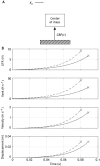Yank: the time derivative of force is an important biomechanical variable in sensorimotor systems
- PMID: 31515280
- PMCID: PMC6765171
- DOI: 10.1242/jeb.180414
Yank: the time derivative of force is an important biomechanical variable in sensorimotor systems
Abstract
The derivative of force with respect to time does not have a standard term in physics. As a consequence, the quantity has been given a variety of names, the most closely related being 'rate of force development'. The lack of a proper name has made it difficult to understand how different structures and processes within the sensorimotor system respond to and shape the dynamics of force generation, which is critical for survival in many species. We advocate that ∂[Formula: see text]/∂t be termed 'yank', a term that has previously been informally used and never formally defined. Our aim in this Commentary is to establish the significance of yank in how biological motor systems are organized, evolve and adapt. Further, by defining the quantity in mathematical terms, several measurement variables that are commonly reported can be clarified and unified. In this Commentary, we first detail the many types of motor function that are affected by the magnitude of yank generation, especially those related to time-constrained activities. These activities include escape, prey capture and postural responses to perturbations. Next, we describe the multi-scale structures and processes of the musculoskeletal system that influence yank and can be modified to increase yank generation. Lastly, we highlight recent studies showing that yank is represented in the sensory feedback system, and discuss how this information is used to enhance postural stability and facilitate recovery from postural perturbations. Overall, we promote an increased consideration of yank in studying biological motor and sensory systems.
Keywords: Biomechanics; Muscle; Spindle.
© 2019. Published by The Company of Biologists Ltd.
Conflict of interest statement
Competing interestsThe authors declare no competing or financial interests.
Figures





Similar articles
-
Comparison of methods of derivation of the yank-time signal from the vertical ground reaction force-time signal for identification of movement-related events.J Biomech. 2021 Jan 22;115:110048. doi: 10.1016/j.jbiomech.2020.110048. Epub 2020 Sep 19. J Biomech. 2021. PMID: 33272585
-
The use of yank-time signal as an alternative to identify kinematic events and define phases in human countermovement jumping.R Soc Open Sci. 2020 Aug 26;7(8):192093. doi: 10.1098/rsos.192093. eCollection 2020 Aug. R Soc Open Sci. 2020. PMID: 32968500 Free PMC article.
-
Sensorimotor integration for functional recovery and the Bobath approach.Motor Control. 2011 Apr;15(2):285-301. doi: 10.1123/mcj.15.2.285. Motor Control. 2011. PMID: 21628730 Review.
-
A novel theoretical framework for the dynamic stability analysis, movement control, and trajectory generation in a multisegment biomechanical model.J Biomech Eng. 2009 Jan;131(1):011002. doi: 10.1115/1.3002763. J Biomech Eng. 2009. PMID: 19045918
-
Postural perturbations: new insights for treatment of balance disorders.Phys Ther. 1997 May;77(5):517-33. doi: 10.1093/ptj/77.5.517. Phys Ther. 1997. PMID: 9149762 Review.
Cited by
-
Fabric-based lamina emergent MXene-based electrode for electrophysiological monitoring.Nat Commun. 2024 Oct 2;15(1):5974. doi: 10.1038/s41467-024-49939-x. Nat Commun. 2024. PMID: 39358330 Free PMC article.
-
Evaluation of force feedback in walking using joint torques as "naturalistic" stimuli.J Neurophysiol. 2021 Jul 1;126(1):227-248. doi: 10.1152/jn.00120.2021. Epub 2021 Jun 9. J Neurophysiol. 2021. PMID: 34107221 Free PMC article.
-
Behavioural energetics in human locomotion: how energy use influences how we move.J Exp Biol. 2025 Feb 15;228(Suppl_1):JEB248125. doi: 10.1242/jeb.248125. Epub 2025 Feb 20. J Exp Biol. 2025. PMID: 39973202 Free PMC article. Review.
-
Temporal response of post-activation performance enhancement induced by a plyometric conditioning activity.Front Sports Act Living. 2023 Jun 27;5:1209960. doi: 10.3389/fspor.2023.1209960. eCollection 2023. Front Sports Act Living. 2023. PMID: 37440876 Free PMC article.
-
Movement History Influences Pendulum Test Kinematics in Children With Spastic Cerebral Palsy.Front Bioeng Biotechnol. 2020 Aug 7;8:920. doi: 10.3389/fbioe.2020.00920. eCollection 2020. Front Bioeng Biotechnol. 2020. PMID: 32850754 Free PMC article.
References
-
- Alexander R. M. (1989). Sequential joint extension in jumping. Hum. Mov. Sci. 8, 339-345. 10.1016/0167-9457(89)90038-9 - DOI
-
- Bennett A. F. & Huey R. B. (1990). Studying the evolution of physiological performance. In Oxford Surveys in Evolutionary Biology (ed. Futuyma D. J. and Antonovics J.), pp. 251-284. Oxford University Press.
-
- Biewener A. A. and Blickhan R. (1988). Kangaroo rat locomotion: design for elastic energy storage or acceleration? J. Exp. Biol. 140, 243-255. - PubMed
Publication types
MeSH terms
Grants and funding
LinkOut - more resources
Full Text Sources
Research Materials

